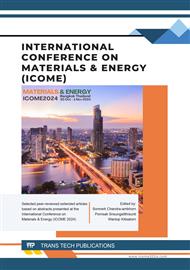[1]
S. Vigneshvar, C.C. Sudhakumari, B. Senthilkumaran, H. Prakash, Recent advances in biosensor technology for potential applications - an overview, Front. Bioeng. Biotechnol. Vol.4, (2016) p.1–9
DOI: 10.3389/fbioe.2016.00011
Google Scholar
[2]
M.L. Sin, K.E. Mach, P.K. Wong, J.C. Liao, Advances and challenges in biosensorbased diagnosis of infectious diseases, Expert Rev. Mol. Diagn. Vol. 14, (2014) p.225–244
Google Scholar
[3]
N.F.D. Silva, J.M.C.S. Magalhaes, C. Freire, C. Delerue-Matos, Electrochemical biosensors for Salmonella: state of the art and challenges in food safety assessment, Biosens. Bioelectron, vol. 99, (2018) p.667–682
DOI: 10.1016/j.bios.2017.08.019
Google Scholar
[4]
D. Antuna-Jimenez, M.B. Gonzalez-García, D. Hernandez-Santos, P. Fanjul-Bolado, Screen-printed electrodes modified with metal nanoparticles for small molecule sensing, Biosensors, vol. 10, (2020) pp.1-22
DOI: 10.3390/bios10020009
Google Scholar
[5]
G. Hughes, K. Westmacott, K.C. Honeychurch, A. Crew, R.M. Pemberton, J.P. Hart, Recent advances in the fabrication and application of screen-printed electrochemical (bio)sensors based on carbon materials for biomedical, agri-food and environmental analyses, Biosensors, vol. 6(50), (2016) pp.1-39
DOI: 10.3390/bios6040050
Google Scholar
[6]
M. Li, Y.T. Li, D.W. Li, Y.T. Long, Recent developments and applications of screenprinted electrodes in environmental assays-A review, Anal. Chim. Acta, vol.734, (2012) p.31–44.
DOI: 10.1016/j.aca.2012.05.018
Google Scholar
[7]
V. Polan, J. Soukup, K. Vytras, Screen-printed carbon electrodes modified by rhodium dioxide and glucose dehydrogenase, Enzym. Res. Vol.2010, (2010) pp.1-7
DOI: 10.4061/2010/324184
Google Scholar
[8]
A. Muhammad, R. Hajian, N.A. Yusof, N. Shams, J. Abdullah, P.M. Woi, H. Garmestani, A screen printed carbon electrode modified with carbon nanotubes and gold nanoparticles as a sensitive electrochemical sensor for determination of thiamphenicol residue in milk, RSC Adv., vol.8, (2018) pp.2714-2722.
DOI: 10.1039/c7ra07544h
Google Scholar
[9]
J.K. Jadav, V.V. Umrania, K.J. Rathod, B.A. Golakiya, Development of silver/ carbon screen-printed electrode for rapid determination of vitamin C from fruit juices, LWT - Food Sci. Technol.(Lebensmittel-Wissenschaft -Technol.), vol. 88, (2018) p.152–158
DOI: 10.1016/j.lwt.2017.10.005
Google Scholar
[10]
S.Z. Mohammadi, H. Beitollahi, S. Tajik, Nonenzymatic coated screen-printed electrode for electrochemical determination of acetylcholine, Micro Nano Syst. Lett., Vol.6, (2018) pp.1-7
DOI: 10.1186/s40486-018-0070-5
Google Scholar
[11]
K.F. Chan, H.N. Lim, N. Shams, S. Jayabal, A. Pandikumar, N.M. Huang, Fabrication of graphene/gold-modified screen-printed electrode for detection of carcinoembryonic antigen, Mater. Sci. Eng. C, vol. 58, (2016) p.666–674.
DOI: 10.1016/j.msec.2015.09.010
Google Scholar
[12]
A.C. Ward, A.J. Hannah, S.L. Kendrick, N.P. Tucker, G. MacGregor, P. Connolly, Identification and characterisation of Staphylococcus aureus on low cost screen printed carbon electrodes using impedance spectroscopy, Biosens. Bioelectron., vol. 110, (2018) p.65–70
DOI: 10.1016/j.bios.2018.03.048
Google Scholar
[13]
T.T.N. Do, T. Van Phi, T.P. Nguy, P. Wagner, K. Eersels, M.C. Vestergaard, L.T. N. Truong, Anisotropic in situ-coated AuNPs on screen-printed carbon surface for enhanced prostate-specific antigen impedimetric aptasensor, J. Electron. Mater., vol. 46, (2017) p.3542–3552
DOI: 10.1007/s11664-016-5187-9
Google Scholar
[14]
B. Yang, D. Bin, J. Wang, S. Li, P. Yang, C. Wang, Y. Shiraishi, Y. Du, Electrochemical synthesis of gold nanoparticles decorated flower-like graphene for high sensitivity detection of nitrite, J. Colloid Interface Sci. vol.488, (2017) p.135–141
DOI: 10.1016/j.jcis.2016.10.088
Google Scholar
[15]
Y. Zhang, X. Li, D. Li, Q. Wei, A laccase based biosensor on AuNPs-MoS2 modified glassy carbon electrode for catechol detection, Colloids Surf. B Biointerfaces, vol. 186, (2020) p.110683.
DOI: 10.1016/j.colsurfb.2019.110683
Google Scholar
[16]
Y. Li, S. Xu, H.J. Schluesener, Gold nanoparticle based biosensors, Gold Bull., vol. 43, (2010) p.29–41
DOI: 10.1007/bf03214964
Google Scholar
[17]
D. Zhao, Y. Liu, Q. Zhang, Y. Zhang, W. Zhang, Q. Duan, Z. Yuan, R. Zhang, S. Sang, Surface stress-based biosensor with stable conductive AuNPs network for biomolecules detection, Appl. Surf. Sci., vol.491, (2019) p.443–450
DOI: 10.1016/j.apsusc.2019.06.178
Google Scholar
[18]
X. Cao, Y. Ye, S. Liu, Gold nanoparticle-based signal amplification for biosensing, Anal. Biochem. vol.417, (2011) p.1–16
DOI: 10.1016/j.ab.2011.05.027
Google Scholar
[19]
J.M. Pingarron, P. Yanez-Sede no, A. Gonzalez-Cortes, Gold nanoparticle-based electrochemical biosensors, Electrochim. Acta, vol. 53, (2008) p.5848–5866
Google Scholar
[20]
Hozhabr Araghi S, Entezari MH, Amino-functionalized silica magnetite nanoparticles for the simultaneous removal of pollutants from aqueous solution, Appl Surf Sci, vol.333, (2015) p.68–77
DOI: 10.1016/j.apsusc.2015.01.211
Google Scholar
[21]
Apetrei, I.M.; Apetrei, C., The biocomposite screen-printed biosensor based on immobilization of tyrosinase onto the carboxyl functionalised carbon nanotube for assaying tyramine in fish products. J. Food Eng., vol.149, (2015) p.1–8
DOI: 10.1016/j.jfoodeng.2014.09.036
Google Scholar
[22]
Ghasemzadeh MA, Abdollahi-Basir MH, Babaei M, Fe3O4@SiO2–NH2 core-shell nanocomposite as an efficient and green catalyst for the multi-component synthesis of highly substituted chromeno[2,3-b]pyridines in aqueous ethanol media, Green Chem Lett Rev, vol.8, (2015) p.40–49
DOI: 10.1080/17518253.2015.1107139
Google Scholar
[23]
Ji, D.; Liu, L.; Li, S.; Chen, C.; Lu, Y.; Wu, J.; Liu, Q. Smartphone-Based Cyclic Voltammetry System with Graphene Modified Screen Printed Electrodes for Glucose Detection, Biosens. Bioelectron., vol.98, (2017) p.449–456
DOI: 10.1016/j.bios.2017.07.027
Google Scholar



